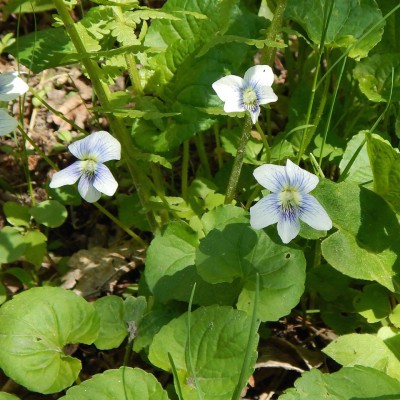Violet species (Violaceae)
Small herbaceous plants of woods and fields; flowers are blue, purple, white, or yellow, according to species; deep green, heart-shaped leaves in basal rosettes or on ascending stems; a good groundcover and a vigorous self-seeder.
By Pamela Johnson

Violets are found in temperate regions worldwide; there are perhaps five hundred species, though numbers are approximated because violets hybridize easily, no matter where they grow.
There are eighteen viola species in Maine, including the rare New England Violet (Viola novae-angliae), and almost as many subspecies or hybrids. Some violets live in specialized habitats, and, of course, not all violets are violet-colored: some are white, a few are yellow, the remainder are shades of blue and purple. What all native violets share is the tendency to flower early and an unusual strategy that insures seed production if blossoms and pollinators fail to connect when spring begins.
Violet flowers are perfectly evolved for precocious pollinators, the early small bees and flies who emerge when ground temperatures first warm. Regardless of the species’s general flower color, violet petals have striations that lure and guide pollinators to the flower’s nectary. The coloration can be flagrant: deep purple veins augmented with “beards”, raised hairs that bees have to wiggle through to penetrate the nourishing delights within the flower’s interior. Or the markings may be more subtle: paler nettings of purple which still provide signposts for pollinators (bees are preternaturally attracted to the cyanic spectrum – shades of blue and purple).
Violet flowers are evanescent, however: they open, and fade quickly in Spring’s faithless weather. It may be that temperatures are too cold, or winds too fierce, for pollinators to appear, though day length has prompted flowering. So violets produce alternate flowers, usually beneath the plants’ lowest leaves. They are petal-less cleistogamous flowers that look like capsules, and are self-pollinated. “Cleisto-”comes from the Greek word for “closed”. The fully developed aerial violet flowers that require pollination are called chasmogamous flowers. Chasmogamy’s Greek root is the word for “wide opening”, chásm(a).
The disadvantage of cleistogamy is the absence of genetic refreshment. Seeds produced will only have the parent plant’s traits; perpetuation is guaranteed, but at the cost of diversity. Also, since cleistogamous capsules are so close to the ground, ripened seed may not travel far from home. Violet seeds can be ejected with some velocity as the membranes holding seeds in place shrink and expel their contents, sometimes 3 to 4 feet distant; but this seed-shattering/seed-scattering is more effective above the foliage and stems.
Seed dispersal is also abetted by ants. Violet seeds have an appendage that looks like a glistening cuticle, or perhaps, to an ant, like a larval morsel. The protuberance, called an elaiosome, is found on the seeds of many native woodland species, as well as viola species. Elaiosomes mimic animal proteins; their chemistry is a magnet to ants who carry off the seeds and feed their broods with these fatty, protein-rich bonanzas. The hard-coated seeds themselves are of little interest to the ants, and are discarded into ant-created waste heaps (middens) that are a good, nutritive, growing medium for seeds. Myrmecochory is the name for seed dispersal by ants, and three ant species do much of the work: Myrmica punctiventris, the punctured ant; Aphaenogaster picea, the pitch-black Aphaenogaster; and A. rudis, the rough Aphaenogaster. As many as thirty percent of spring-flowering herbaceous plant species in the forests of North American benefit from myrmecochory. Some studies have indicated that ant dispersal engenders more vigorous plants.
The violet’s insect retinue is large, and includes other numbers of the Hymenoptera family (bees and wasps) along with the seed-dispersing ant species. Violets are pollinated primarily by sweat bees (Halictidae) and mason bees (the genus Osmia). Occasionally bumblebees (Bombycidae), too burly for the violet’s petalled access, will nip off a violet’s spur to access nectar without providing pollination services. Syrphid flies (Syrphidae) visit violets for stray pollen, but they are not reliable pollinators like the small bees.
The caterpillars of many fritillary butterflies feed on violet leaves. The meadow fritillary (Boloria bellona), the great-spangled fritillary (Speyeria cybele) whose wingspan would cover the width of a single small violet plant, the Aphrodite (Speyeria aphrodite), and the variegated fritillary (Euptoieta claudia), all avail themselves of violets. As do gall midges (Phytophaga viotidae), violet sawflies (Amastasteiga pallipes), and the elegant crane flies (Tipulidae), sometimes the seasonally earliest and latest flying insects.
Grouse, juncos, mourning doves, and small mammals eat violet seeds and wild turkeys eat their roots; deer and cottontail rabbits eat the foliage of violets. Violets have been used medicinally: the mucilaginous leaves are used to thicken stews, and decoctions can be made for pain relief and treatments for inflammation. The leaves are “salett” herbs (and potherbs), beneficial for their strong concentrations of Vitamins C and A.
A discussion about individual violet species would consume a lot of space; field guides are necessary for distinguishing many species and their hybrids. Even botanists sometimes resort to the initials “l.b.v.” when asked to identify a tricky species: little blue violet is the expedient without a great deal of scrutiny. The challenge is out there for those willing to tackle clavate hairs, spur lengths, leaf lobes, and sepal cilia.
The season of violets will soon arrive, sweet heralds of the wild flower parade. In Forest and Thicket, John Eastman writes:
It’s the most visible beginning, this low blue flame in the woods. I think of it as a pilot light that ignites the entire burst of resurrection we call spring.[iii]
Collecting seeds from violets takes a little observation. Within a week or two of the last flowers appearances, check the plants regularly for the ½″ pale green seedpods. The pods point downward until the seeds begin to ripen, when they turn tan and papery, and reorient, pointing upwards. If the seeds have begun to turn brown they are ripe and ready to collect. (Seeds explode outward when the pods split.) Seeds can be sown immediately in pots outdoors, left to dry for a few weeks in a paper bag, then put in the refrigerator in a sealed jar or bag for fall sowing. Germination will occur the following spring.
[iii] Eastman, John. 1992. Forest and Thicket Mechanicsburg, PA; Stackpole Books. p. 197.

